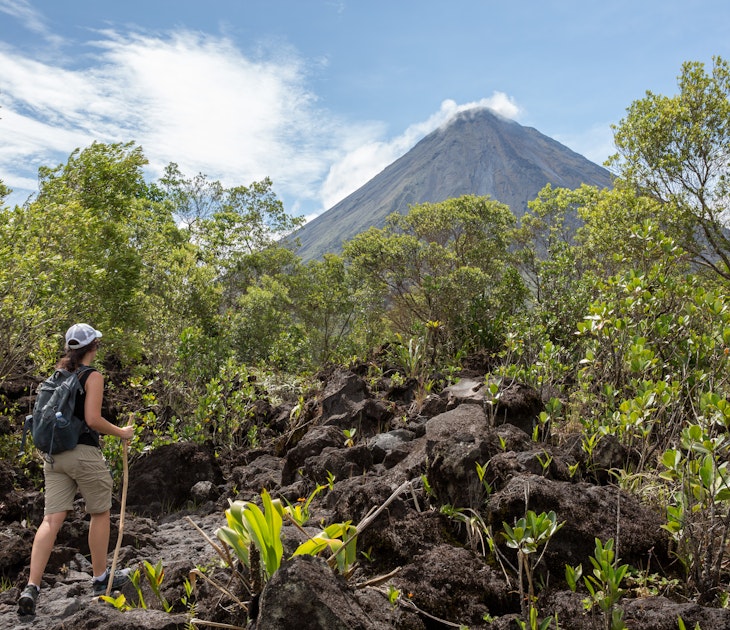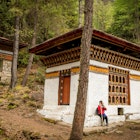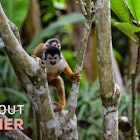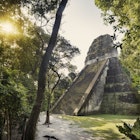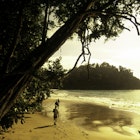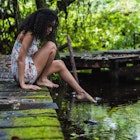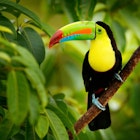Jutting into the sea at the southern end of Costa Rica’s Pacific coast, the Osa Peninsula remains one of the country’s most remote destinations.
This wild region is worth the trip: to explore the vast rainforest that shelters Costa Rica's largest remaining population of jaguars and tapirs, to surf the cerulean waves along the peninsula’s southern point and to take a boat ride through its enormous expanse of mangroves.
The Osa Peninsula is also a great place to get a glimpse into Costa Rica's past. Former gold mining villages introduce visitors to rural Tico life and enormous pre-Columbian stone spheres continue to baffle archaeologists. Despite the vastly improved access road to the peninsula’s main town, other parts of Osa remain off the grid, but don't let that intimidate you. The rewards for tackling the rough roads, hiking trails and river crossings are many.
What travel looks like in Costa Rica in 2021

Corcovado National Park
Parque Nacional Corcovado, one of Costa Rica’s star attractions, takes up almost half of the Osa Peninsula and is home to an astoundingly diverse range of wildlife, including the highly endangered giant anteater, tapir, harpy eagle and all of Costa Rica’s big cats. Whether you access the heart of the park via a grueling day hike along one of its two main jungle trails, the coastal La Leona to Sirena or the mountainous Sirena to Los Patos, or arrive by boat to explore the shorter trails around the Sirena and San Pedrillo ranger stations, wildlife sightings are virtually guaranteed. There’s also a short trail loop from Dos Brazos that gives visitors a quick taste of the park.
You can combine a Sirena–Los Patos hike with a stay at La Tarde, an inviting property just outside the park that offers nightly tours to see snakes and frogs. Visits to Corcovado are permitted only with licensed guides, so organize your jungle adventure in Puerto Jiménez with Osa Wild, Surcos Tours or Osa Aventura, or in Bahía Drake with Corcovado Expeditions or Pacheco Tours.
The best national parks in Costa Rica

Drake Bay
Reachable via an exhilarating speedboat ride through the mangroves from Sierpe, by plane or via a 4WD-only road that requires driving through rivers, Bahía Drake consists of a sprawling village and a gorgeous 10.5-mile (17km) coastal trail that leads to the San Pedrillo entrance of Parque Nacional Corcovado. Drake Bay appeals both to upmarket travelers who come to stay in the high-end jungle lodges such as Copa de Arbol and the Drake Bay Getaway Resort, and backpackers, as an increasing number of budget guesthouses and tour operators make it easy to visit Corcovado on a day trip, go diving, kayak in the mangroves or go wildlife-spotting in the rainforest.
The 12 best beaches in Costa Rica
Puerto Jiménez
The closest that the Osa Peninsula gets to a bustling capital, Puerto Jiménez's compact grid of dusty streets is the preferred budget traveler jump-off point for visiting Corcovado, thanks to its proliferation of affordable digs such as Osa Jungle Hostel and Cabinas Back Packer, a well-stocked supermarket and numerous tour agencies. After your jungle adventure, you can unwind on the Playa Platanares, kayak on the Golfo Dulce, go abseiling down waterfalls with Psycho Tours, or dig into some of the Osa Peninsula’s best culinary offerings at La Perla de Osa or Cafetería Monka.

Cabo Matapalo and Carate
South of Puerto Jiménez, the rough road crosses several shallow rivers as it makes its bumpy way to the beach settlement of Cabo Matapalo, the "toe" of the Osa Peninsula "boot," where surfers in the know hit the virtually empty waves from surf-and-yoga retreats such as Ojo del Mar and Encanta La Vida. Continuing on to Carate, the starting point for hikes in Corcovado, this rough road is lined with some of Costa Rica’s best all-inclusive wilderness lodges, such as Lapa Ríos, El Remanso Lodge and Luna Lodge. These properties offer gourmet cuisine, all manner of creature comforts as well as nature adventures. Expert guides lead walks into the enveloping jungle, a terrific place to spot monkeys, sloths, birds and other creatures.
The 20 best places to visit in Costa Rica

Rural tourism
Part of the new Caminos de Osa initiative that aims to develop more hiking trails across the Osa Peninsula and boost rural tourism in local communities, the two former gold mining villages of Rancho Quemado and Dos Brazos welcome visitors with a range of attractions. See how cane sugar is made at Trapiche Don Carmen in Rancho Quemado, or go gold panning, wildlife watching or horseback riding in Dos Brazos with guides organized through the Dos Brazos Oficina de Turismo. In Dos Brazos, you can also sleep at the Los Mineros Guesthouse in the former goldminers’ brothel and jail, or go completely off the grid at the Bolita Rainforest Hostel, a rustic farmhouse with no electricity or running water. If you don’t know where your hot chocolate comes from, an illuminating tour of the organic cacao farm at Finca Köbö, off the main road from Puerto Jiménez, is just the ticket.
Humedal Nacional Terrába-Sierpe
The back end of the Osa "boot" dissolves into a network of channels and waterways that weave around the Humedal Nacional Térraba-Sierpe, the country’s largest mangrove swamp. Its 127 sq miles (330 sq km) of wetland, home to red, black and tea mangrove species, protects a plethora of birdlife – especially water birds such as herons, egrets and cormorants – as well as larger denizens of the murky waters, such as caimans and boas. An exploration of this watery world by boat with Bahía Aventuras in Uvita or Corcovado Expeditions in Bahía Drake gives you a unique insight into this special and fragile ecosystem.

Isla del Caño
A 40-minute boat ride from Bahía Drake brings you to the uninhabited island of Isla del Caño, the centerpiece of one of Costa Rica’s most important marine reserves and a top diving and snorkeling destination. Brain corals, sea plumes, fans and other coral species shelter the threatened Panulirus lobster and the giant conch, while the huge schools of tropical fish attract dolphins and whales. Top dive sites include the Devil’s Pinnacle, a spot frequently visited by reef sharks, manta rays and barracudas, and Paraside, where you’ll see hammerhead sharks and sea turtles if you're lucky. The only way to reach the island is on a snorkeling or diving tour, arranged by most accommodations in Bahía Drake, as well as operators such as Drake Divers.
Sitio Arqueológico Finca 6
The excellent museum at Sitio Arqueológico Finca 6, halfway between the Costanera Sur and Sierpe, offers the best opportunity to view the pre-Columbian stone spheres that are Costa Rica’s most important archaeological finds. Included on Unesco's list of World Heritage sites, these stones are pretty much the only traces left behind by the mysterious Diquís civilization that populated the Diquís Delta. Between 300 BC and 1500 AD, the Diquís invested huge efforts in the creation of these perfectly spherical stone globes, with the largest measuring 8 feet (2.5m) across and weighing a staggering 24 tons. While their purpose is unclear, historians believe that some were status symbols while others were aligned in groups for ceremonial purposes or as solar calendars.
This article was originally published in April 2016.
You might also like:
Discover Costa Rica's most unique tree houses
Camp out in these egg-shaped pods in the Costa Rican jungle
6 road trips in Costa Rica that aren't for the faint of heart

